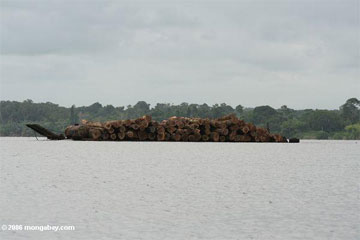Logging resumes in Liberia
Logging resumes in Liberia
mongabay.com
July 17, 2006
As former US president Bill Clinton arrives in Liberia to meet with President Ellen Johnson Sirleaf, it’s time to take a look at the state of the forests in the country.
While Liberia’s brutal civil war delayed the commercial exploitation of its tropical forests during the 1990s, “conflict timber” was a key source of revenue for warring factions. The harvesting of this wood, combined with collateral damage from military operations and wildlife poaching, took a heavy toll on Liberia’s forests. With the end of the war, Liberia’s new government—which took power at end of the war in 1998—immediately established forestry as a national priority and instituted a five-year tax holiday on timber industries. This policy, combined with the return of commercial interests to the country, repopulation, and reconstruction efforts, has put pressure on Liberia’s remaining forest resources. Since the close of the 1990s, deforestation rates have increased by 17 percent, and primary forest cover in the country has fallen to just over 1.3 percent of the total land area (or 4.1 percent of the forest cover).
After granting large concessions to timber firms, the Liberian government essentially lost control over logging in much of the country. In June 2005, the director of the Food and Agriculture Organization of the United Nations in Liberia warned that the forest and its associated resources were at a very “high risk of facing depletion” from illegal logging and land invasions by gold miners.
 African rainforest logs heading to market. |
Since the United Nations Security imposed strict sanctions on Liberia in 2003, the government has not legitimately earned any revenue from the timber sector. As such, virtually all logging in Liberia has been illegal and will continue to be until the country is able to meet conditions set forth by the UN which include: increased transparency in timber transactions, government control over the forestry sector, and the banishment of the use of militias by logging firms. Until the government is able to rein in illicit activities in the country’s forests, illegal logging will continue to take a heavy toll on Liberia’s natural resources. Further pressure from subsistence activities—about 98% of the country’s energy needs are met by fuelwood and charcoal according to the ITTO—will not help the situation.
In June 2006, the UN Security Council decided that is was time to allow Liberia again to start exporting timber given certain conditions, namely the passage of appropriate forestry legislation within a 90-day period. The UN has estimate that logging, once resumed, could yield as much as $80 million in sales a year, of which $15 million would go to the Liberian government.
Despite these challenges and the resumption of commercial logging, things may be looking up for Liberia’s forests. After announcing the expansion of Sapo National Park and the creation of the Nimba Nature Reserve in 2003, the government has worked with international NGOs to monitor and address illegal activities in the country’s national park. In November 2005, Conservation International (CI) led a survey to assess Liberia`s remaining biodiversity. At last count, the country was home to 2,200 species of plants, 193 mammals, and 576 bird species. Further, President Johnson-Sirleaf announced that the government was aiming to raise a $30 million conservation fund to protect its rainforests.